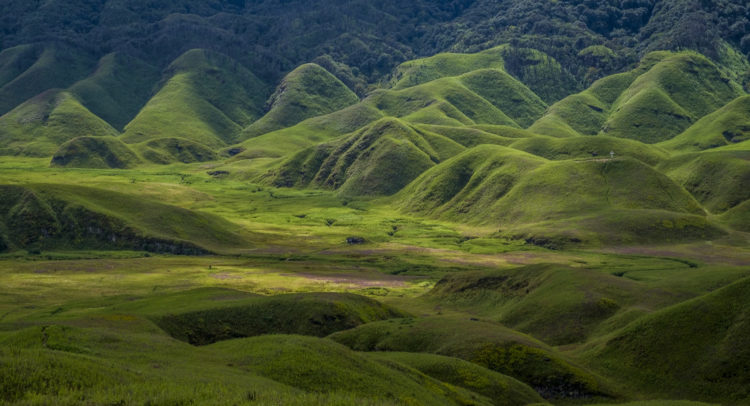
In the far Northeast corner of India not very far away from the dense jungle of Burma lies Longkhum village in Mokokchung District of Nagaland state. Northeast India has become a hot spot for India’s tourism sector over the past few years and Nagaland particularly too is becoming a favored tourist destination specially for its annual Hornbill festival, Dzukou valley, Kohima world war II cemetery as such. However, despite its mega potential Longkhum village is least travelled by both local as well as international tourists and travelers alike and never get the spot light it deserves. Just like Mahatma Gandhi said “The soul of India lies in its villages” so is this village which I believe could become the heart and soul of India’s dynamic tourism industry because it has so much to offer from its scenic beauty to its history and culture to adventure to sustainability and so on. This is not just a place where you get to see and experience a new thing but also it open out our eyes to new ideas and truly inspire us because in here people respect nature and tradition people still understands the language of the winds and the birds as our ancestors did here it look at ‘people’’planet’ and ‘prosperity’ and here it’s all about human-human spirit, regeneration, culture, identity, green building, physical and mental well being here it’s like we stand still with time yet truly inspire us for the future.
Visiting this village trace us back to our roots during our formative days where it all begins. Longkhum is located southwest of Mokokchung district at an altitude of 1846 meter. It is the highest altitude village of the Ao, Naga and known as the ‘Ao-Funemro’ way back during the head hunting times, which means the van-guard village of the Ao country and provide a panoramic view of the majestic surroundings. The Ao Naga believe that Longkhum is the resting place for the spirit of dead on their onward journey to paradise so one mystical and interesting tourist place here that one can find is the ‘Mongzu Ki’ meaning Eagle’s Eyrie- situated at a high precipice where eagles have nested for centuries. According to Ao mythology, eagles are the manifestation of the spirits of the death and also it is believe that ‘’your soul stays back on your first visit to Longkhum so you will have to go back to retrieve your soul’’
Another perhaps astonishing feature to this village is the ‘Longlangba’ or ‘stone bridge’ which is a ridge of stones that passes through the rhododendron woods. The forest has small holes in the rocks that were carved into the stones where the spears could be placed. These were like a warning signs to the enemies that they would be killed and their head will be chop off if they tear try to attack them.
Also one can see the footprints of ‘Ediben’ and ‘Jina’, engraved on the rocks timelessly the adored love birds of the Ao, Naga popularly known as the ‘Romeo’ and ‘Juliet’ of the Ao, Naga during our forefather times. Another less known to many is the ‘Retu-long’ which for a very long time the ancestors considered it as the ‘living stone’
Another fascinating site is the ‘Tanyim marok’ it’s a natural spring oozing from the rocks and believes that water from it has the power to heel any kind of sickness. Some even call it as the ‘Takum Marok’ meaning the ‘Living Mug’ Lower down the ridges in the village is one popular site known as the ‘Fosen ki’ or ‘Rock caves’ which is a delight to the adventurous and also down a little further below is the man-made ‘Majang’ or observatory point where one can see the majestic lofty hills with a backdrop of the Doyang river which is a major river of Nagaland. Also from here one can view the ‘Mongzu-ki’ or the ‘Eagle’s cave’
Again a few kilometers away from the heart of the village, there lays a beautiful waterfall called ‘Tsumeya Tsuin’. It is very high that it does not fit in a camera frame.
Again there is this place known as the ‘Tenem Temba Kong’ it is the place where the hornbill birds used to nest. One needs to climb up really hard to reach to the top.
Planted during the british era there is Pine Grooves that add to the beauty of this village running parallel on both sides of the stairways in the village area, it is one of the favorite sites for photography.
Come autumn it is the time that the cherry blossoms bloom to its full glory which are planted alongside the roads. During this time of the year local tourists and photographers flock into the village to capture nature overwhelmingly beauty at its best.
In the modern times, Longkhum is also known as the ‘vegetable capital’ of Nagaland here one can find organic farming and not only does it provides the villagers with income but visitors are able to interact with them and gain a rare insight into their daily way of life and one can see their farming system and community being build together with the help of people from all walks of life the responsibility that each and every one have as an individual in building up their community putting on the hard work to one another whether it’s about building house and raising up farm physically or building a community mentally everyone being involved.
Author: Sentiyanger Jamir, Mokokchung, Nagaland


